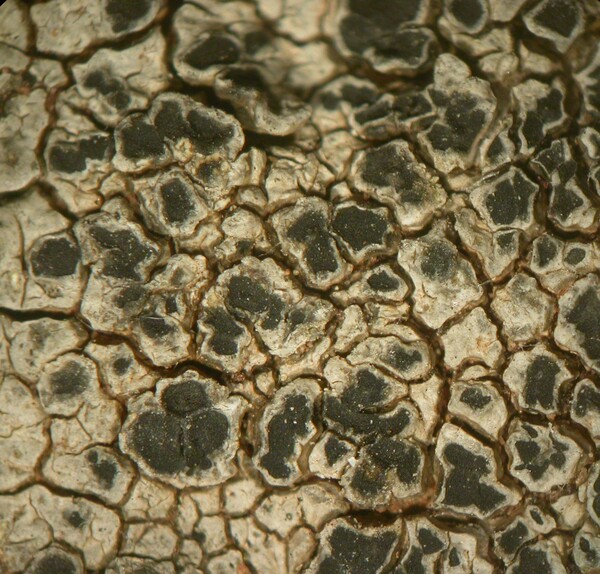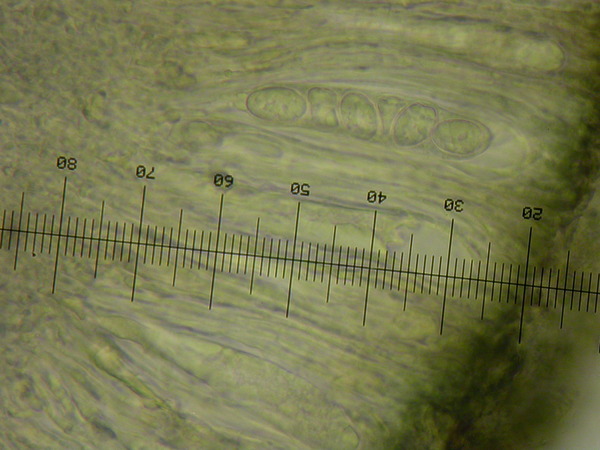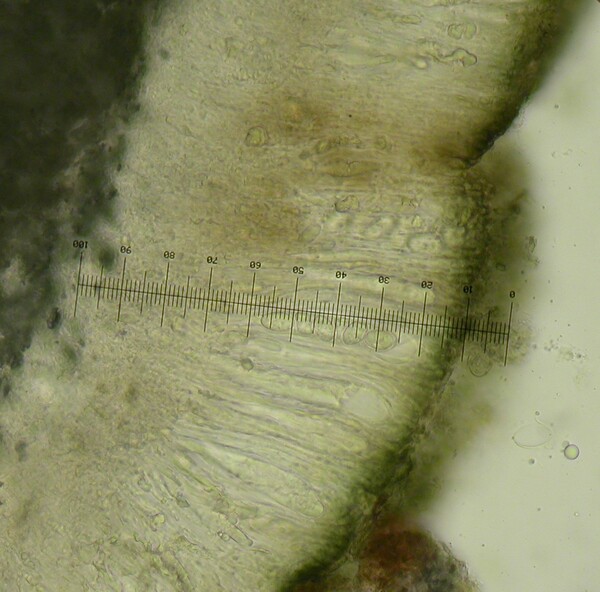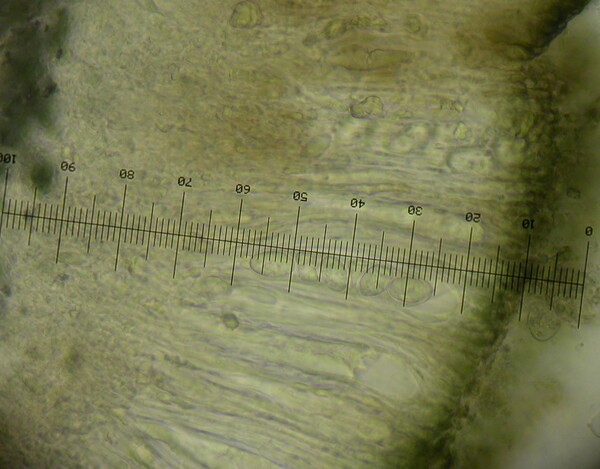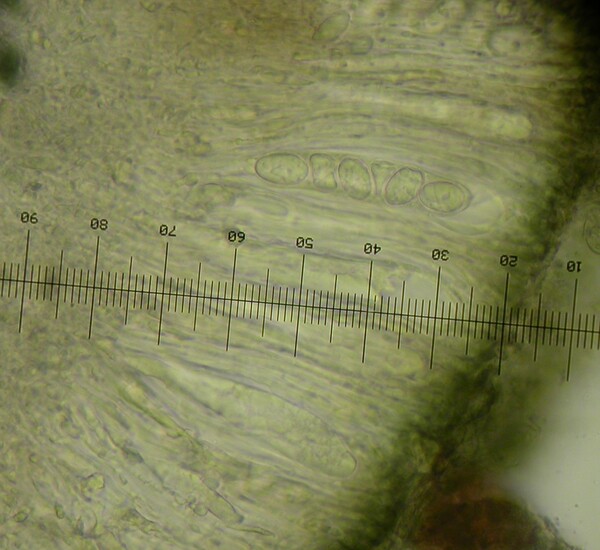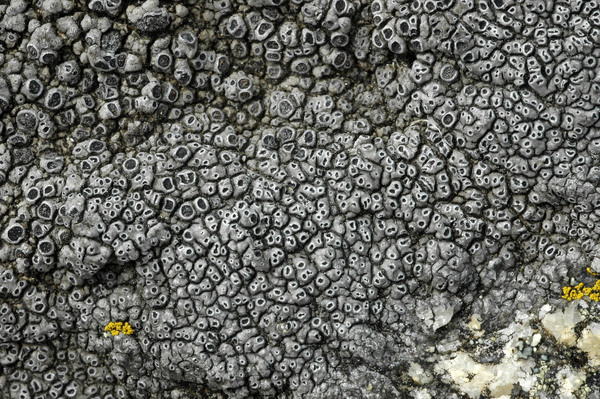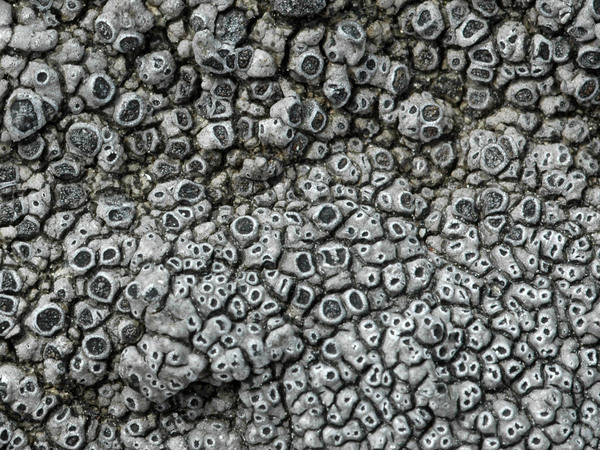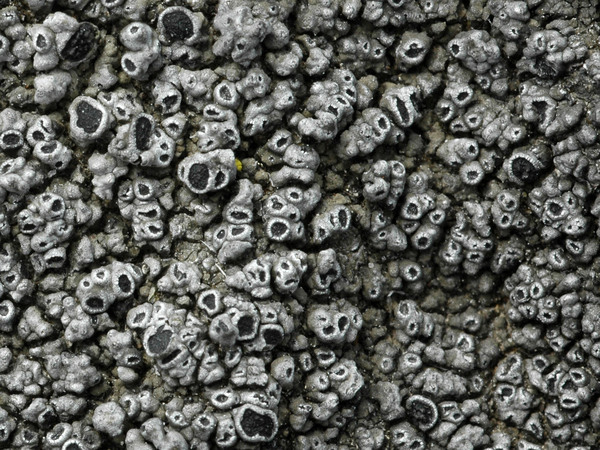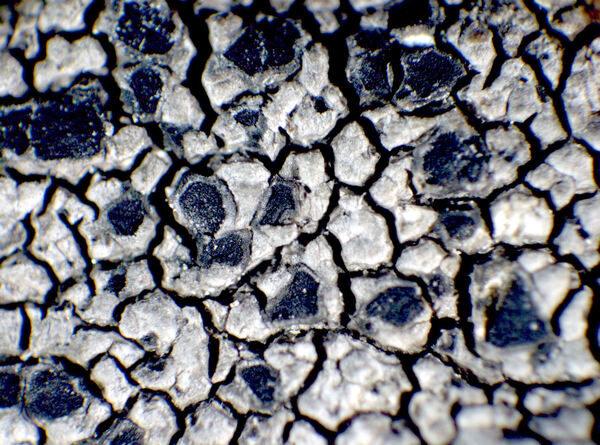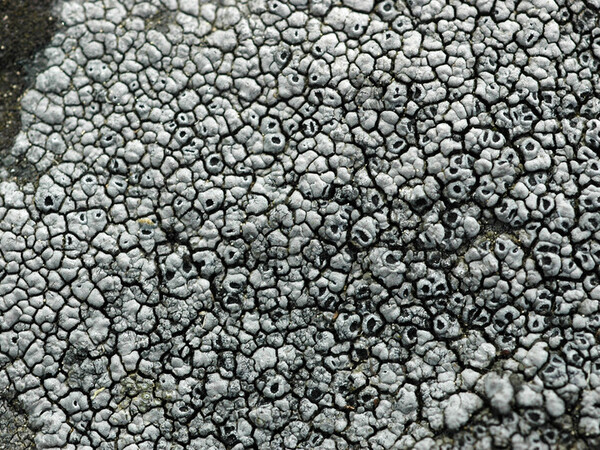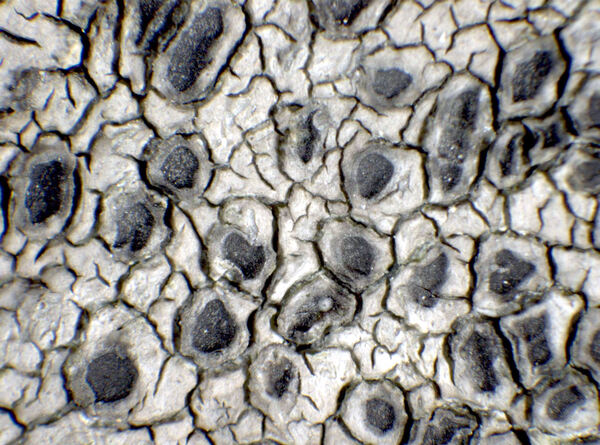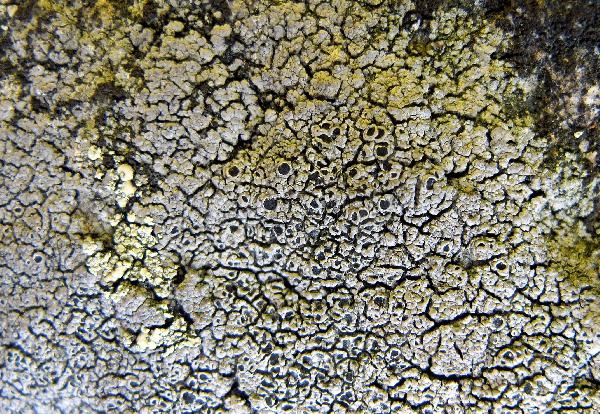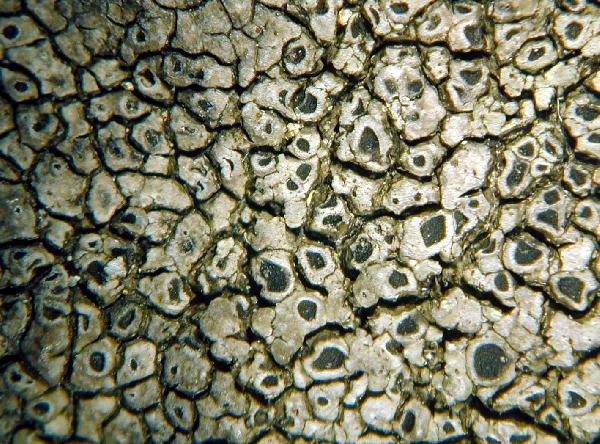Circinaria caesiocinerea (Malbr.) A. Nordin, Savić & Tibell
Mycologia, 102: 1341, 2010. Basionym: Lecanora caesiocinerea Nyl. ex Malbr. - Lich. Normandie: 320, 1870.
Synonyms: Aspicilia caesiocinerea (Malbr.) Arnold; Aspicilia gibbosa auct. non (Ach.) Körb.; Lecanora gibbosa auct. non (Ach.) Nyl. p.p.
Description: Thallus crustose, episubstratic, rimose at the edge, otherwise areolate, grey to blue-grey, rarely grey-brown, (0.2-)0.4-0.6(-1.4) mm thick, forming up to 20 cm wide patches, sometimes delimited by a dark prothallus. Areoles angular to irregular, flat to convex, (0.2-)0.4-1(-2) mm in diam., contiguous, separated by distinct cracks. Cortex brownish in upper part, sometimes covered by an epinecral layer; medulla white, I-. Apothecia aspicilioid, (0.1-)0.4-0.8(-1.3) mm across, 1(-5) per areole, round to angular, with a black, concave to flat, epruinose disc with a rough surface, and a rather thick, raised thalline margin. Epithecium olive to olive-brown, without crystals, N+ emerald green, K+ brown; hymenium colourless, (80-)120-150(-200) µm high, I+ wine-red to yellow-green; paraphyses simple or sparingly branched and anastomosing, 1.5-2 µm thick at mid-level, submoniliform in upper part, with globose to subglobose, 4-5 µm wide uppermost cells; hypothecium colourless, I+ persistently blue or partly turning yellow-green. Asci (4-)6(-8)-spored, clavate, the thin outer coat K/I+ blue, the wall and apical dome K/I-. Ascospores 1-celled, hyaline, ellipsoid to subglobose when young, (14-)18-30(-35) x (7-)10-16(-22) µm. Pycnidia with a black, punctiform ostiole. Conidia thread-like, straight, 6-10(-12) x c. 1 µm. Photobiont chlorococcoid. Spot tests: cortex and medulla K-, C-, KC-, P-. Chemistry: aspicilin.
Growth form: Crustose
Substrata: rocks
Photobiont: green algae other than Trentepohlia
Reproductive strategy: mainly sexual
Poorly known taxon in need of further study
Commonnes-rarity: (info)
Alpine belt: extremely common
Subalpine belt: extremely common
Montane belt: common
Dry submediterranean belt: rather rare
Humid submediterranean belt: rather common
Padanian area: very rare
pH of the substrata:
1 2 3 4 5
Solar irradiation:
1 2 3 4 5
Aridity:
1 2 3 4 5
Eutrophication:
1 2 3 4 5
Poleotolerance:
0 1 2 3
Altitudinal distribution:
1 2 3 4 5 6
Rarity
absent
extremely rare
very rare
rare
rather rare
rather common
common
very common
extremely common
Loading data...
Occurrence data
Predictive map
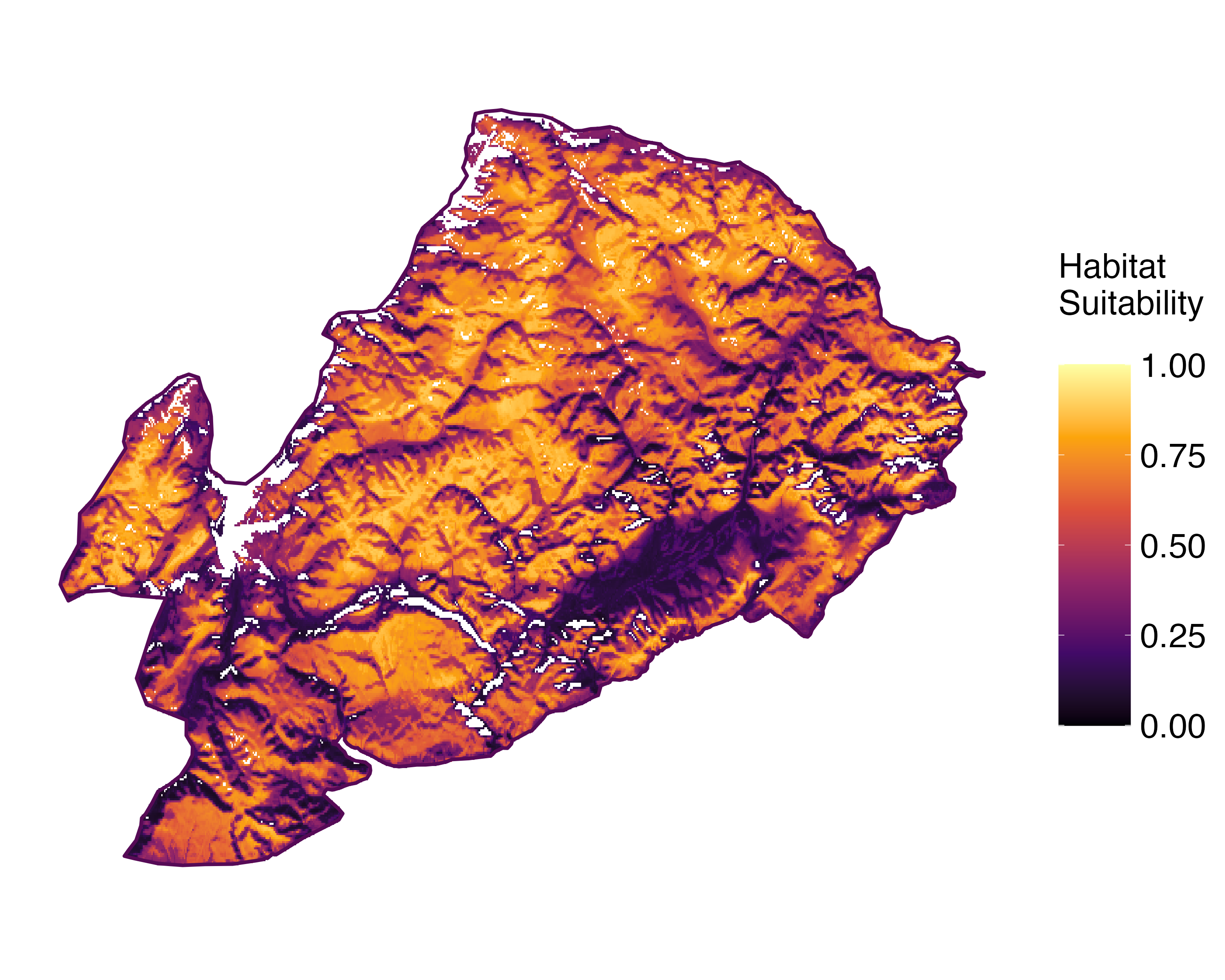 Current prediction (1981-2010)
Current prediction (1981-2010) Future prediction (2071-2100) SSP 1-2.6
Future prediction (2071-2100) SSP 1-2.6 Future prediction (2071-2100) SSP 5-8.5Predictive maps according to Francesconi et al. 2025
Future prediction (2071-2100) SSP 5-8.5Predictive maps according to Francesconi et al. 2025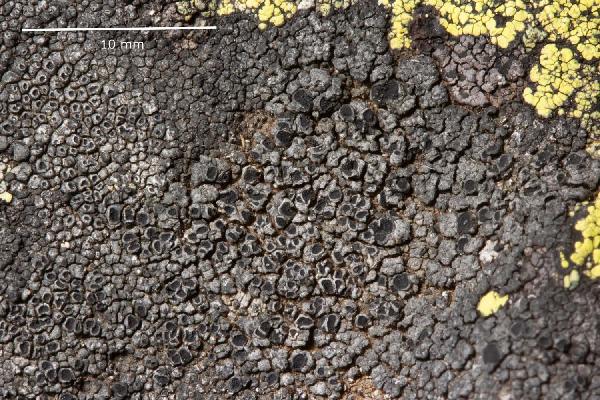
Marta Gonzalez Garcia - Centro de Estudios Micologicos Asturianos
Spain, La Farrapona (Saliencia-Somiedo), 30-V-2023, en rocas ácidas a 1700 m de altitud.
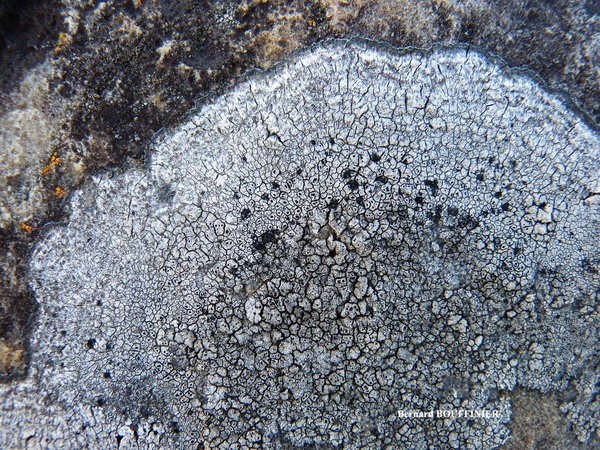
Bernard Bouffinier - Source: http://www.lichensmaritimes.org/index.php?task=fiche&lichen=108&lang=en
Belgium, Kerloc'h
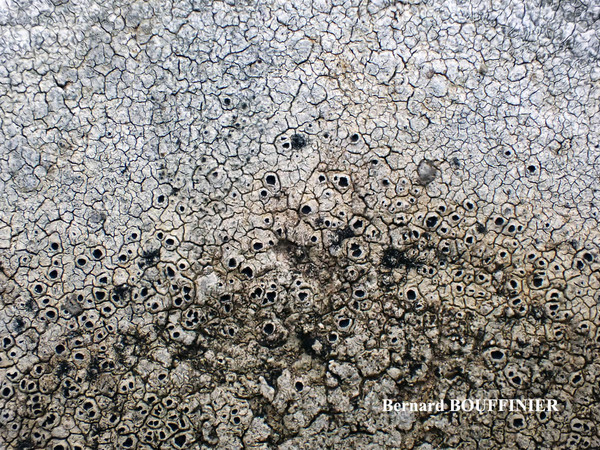
Bernard Bouffinier - Source: http://www.lichensmaritimes.org/index.php?task=fiche&lichen=108&lang=en
Belgium, Kerloc'h
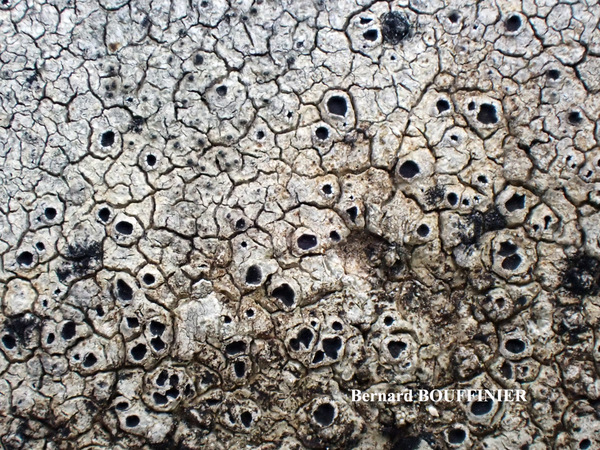
Bernard Bouffinier - Source: http://www.lichensmaritimes.org/index.php?task=fiche&lichen=108&lang=en
Belgium, Kerloc'h
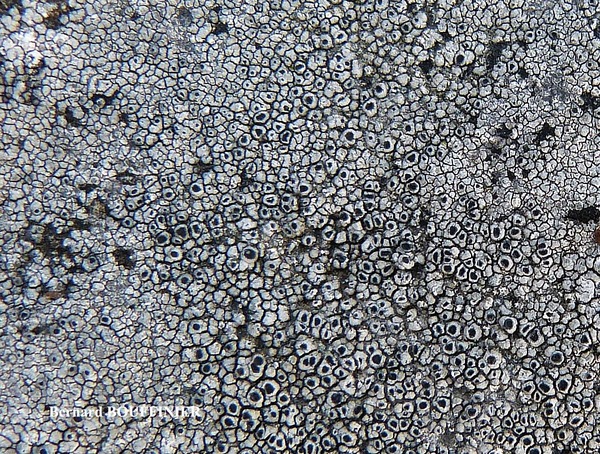
Bernard Bouffinier - Source: http://www.lichensmaritimes.org/index.php?task=fiche&lichen=108&lang=en
Belgium, Kerloc'h
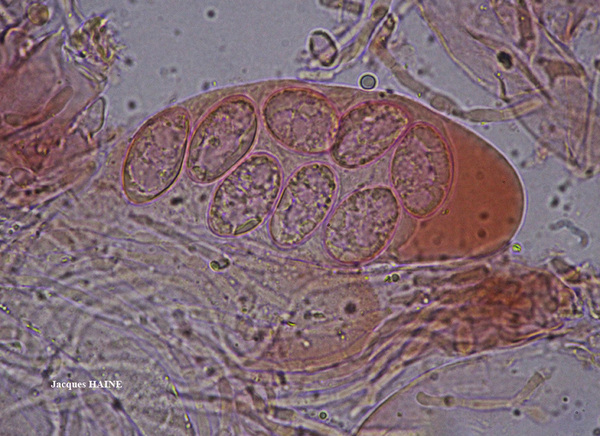
Jacques Haine - Source: http://www.lichensmaritimes.org/index.php?task=fiche&lichen=108&lang=en
Belgium, Monthermé
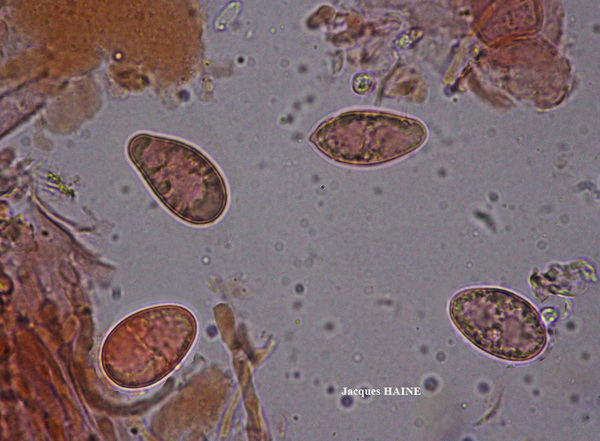
Jacques Haine - Source: http://www.lichensmaritimes.org/index.php?task=fiche&lichen=108&lang=en
Belgium, Monthermé
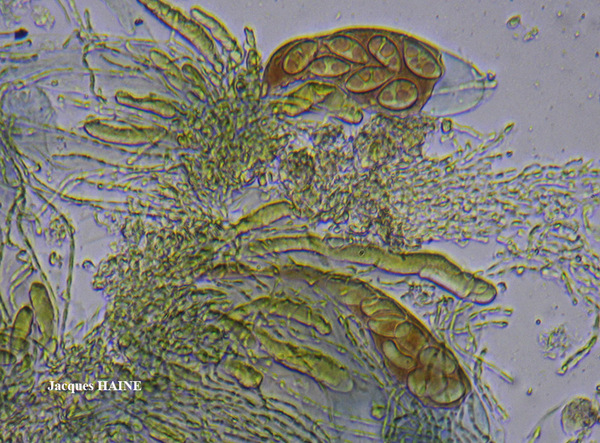
Jacques Haine - Source: http://www.lichensmaritimes.org/index.php?task=fiche&lichen=108&lang=en
Belgium, Monthermé
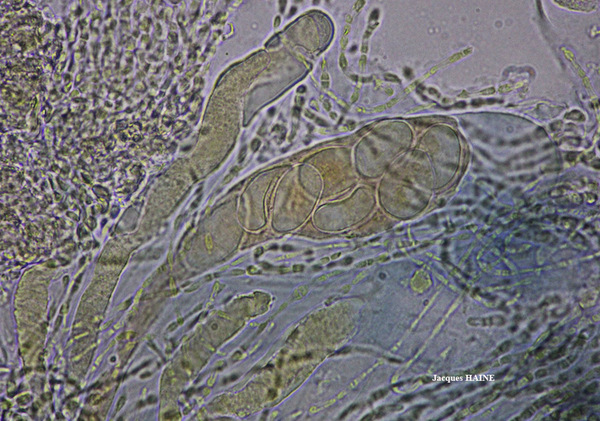
Jacques Haine - Source: http://www.lichensmaritimes.org/index.php?task=fiche&lichen=108&lang=en
Belgium, Monthermé

Ulrich Kirschbaum CC BY-SA 4.0 - Source: https://www.thm.de/lse/ulrich-kirschbaum/flechtenbilder
Central Europe; Germany: Hesse. 150 m above sea level. (Coll/ident: Eichler/Cezanne).
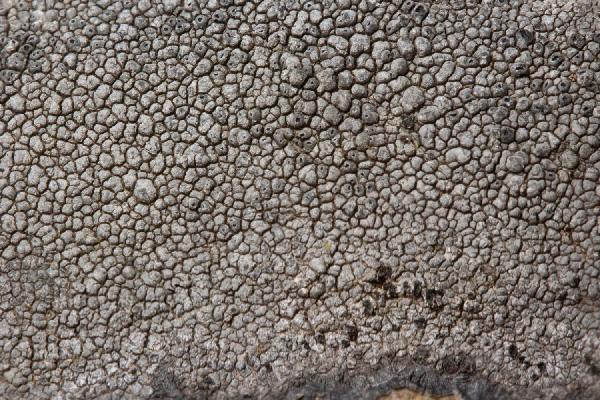
Marta Gonzalez Garcia - Centro de Estudios Micologicos Asturianos
Spain, La Farrapona (Saliencia-Somiedo), 30-V-2023, en rocas ácidas a 1700 m de altitud.

Marta Gonzalez Garcia - Centro de Estudios Micologicos Asturianos
Spain, La Farrapona (Saliencia-Somiedo), 30-V-2023, en rocas ácidas a 1700 m de altitud.

Marta Gonzalez Garcia - Centro de Estudios Micologicos Asturianos
Spain, La Farrapona (Saliencia-Somiedo), 30-V-2023, en rocas ácidas a 1700 m de altitud.
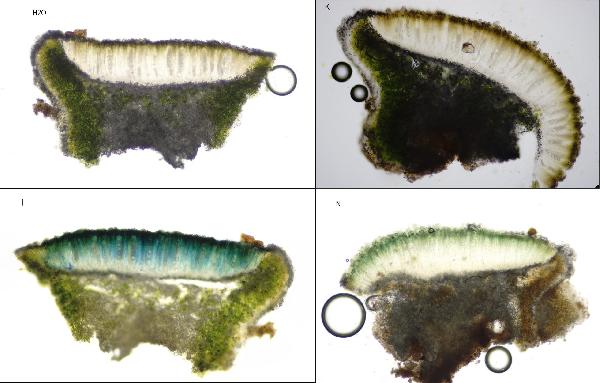
Marta Gonzalez Garcia - Centro de Estudios Micologicos Asturianos
Spain, La Farrapona (Saliencia-Somiedo), 30-V-2023, en rocas ácidas a 1700 m de altitud.
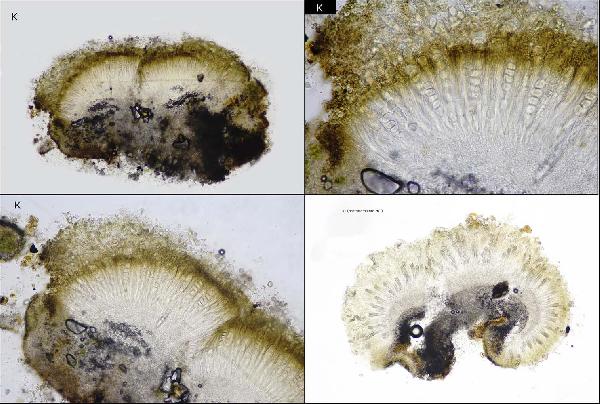
Marta Gonzalez Garcia - Centro de Estudios Micologicos Asturianos
Spain, La Farrapona (Saliencia-Somiedo), 30-V-2023, en rocas ácidas a 1700 m de altitud.
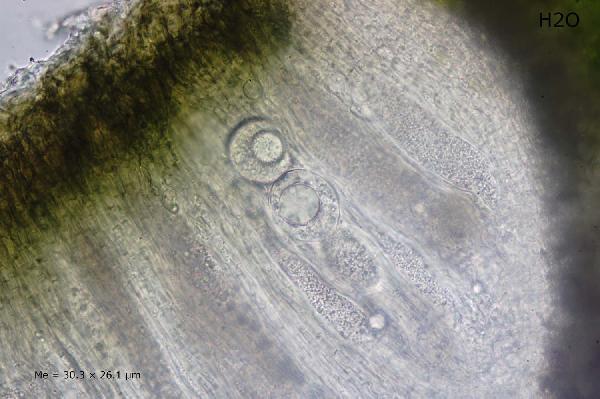
Marta Gonzalez Garcia - Centro de Estudios Micologicos Asturianos
Spain, La Farrapona (Saliencia-Somiedo), 30-V-2023, en rocas ácidas a 1700 m de altitud.
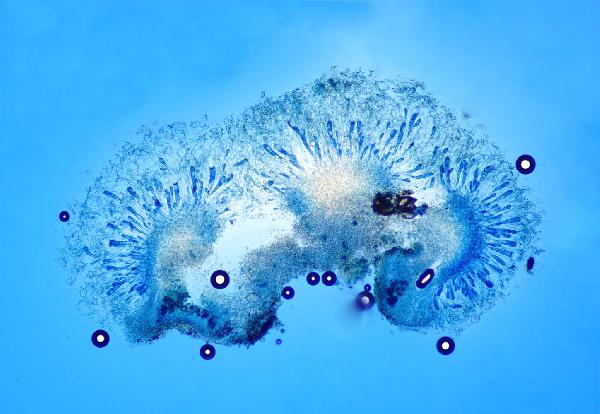
Marta Gonzalez Garcia - Centro de Estudios Micologicos Asturianos
Spain, La Farrapona (Saliencia-Somiedo), 30-V-2023, en rocas ácidas a 1700 m de altitud.
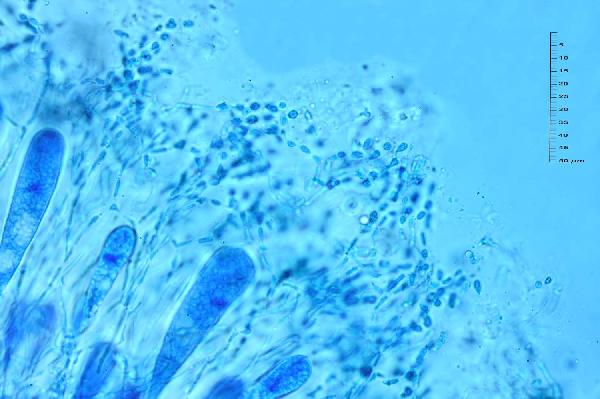
Marta Gonzalez Garcia - Centro de Estudios Micologicos Asturianos
Spain, La Farrapona (Saliencia-Somiedo), 30-V-2023, en rocas ácidas a 1700 m de altitud.
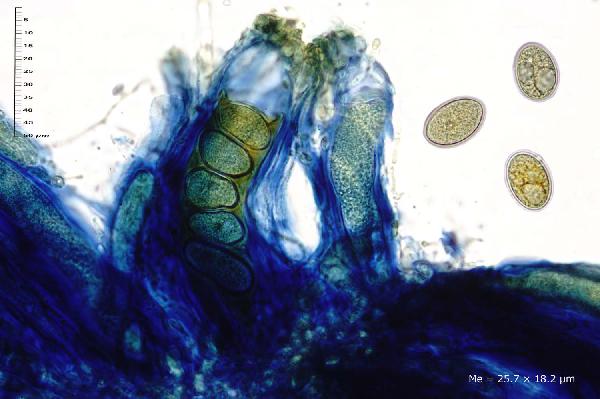
Marta Gonzalez Garcia - Centro de Estudios Micologicos Asturianos
Spain, La Farrapona (Saliencia-Somiedo), 30-V-2023, en rocas ácidas a 1700 m de altitud.
Growth form: Crustose
Substrata: rocks
Photobiont: green algae other than Trentepohlia
Reproductive strategy: mainly sexual
Poorly known taxon in need of further study
Commonnes-rarity: (info)
Alpine belt: extremely common
Subalpine belt: extremely common
Montane belt: common
Dry submediterranean belt: rather rare
Humid submediterranean belt: rather common
Padanian area: very rare
pH of the substrata:
| 1 | 2 | 3 | 4 | 5 |
Solar irradiation:
| 1 | 2 | 3 | 4 | 5 |
Aridity:
| 1 | 2 | 3 | 4 | 5 |
Eutrophication:
| 1 | 2 | 3 | 4 | 5 |
Poleotolerance:
| 0 | 1 | 2 | 3 |
Altitudinal distribution:
| 1 | 2 | 3 | 4 | 5 | 6 |
Rarity
absent
extremely rare
very rare
rare
rather rare
rather common
common
very common
extremely common
Loading data...
Occurrence data
Predictive map
 Current prediction (1981-2010)
Current prediction (1981-2010) Future prediction (2071-2100) SSP 1-2.6
Future prediction (2071-2100) SSP 1-2.6 Future prediction (2071-2100) SSP 5-8.5
Future prediction (2071-2100) SSP 5-8.5Predictive maps according to Francesconi et al. 2025

Marta Gonzalez Garcia - Centro de Estudios Micologicos Asturianos
Spain, La Farrapona (Saliencia-Somiedo), 30-V-2023, en rocas ácidas a 1700 m de altitud.

Bernard Bouffinier - Source: http://www.lichensmaritimes.org/index.php?task=fiche&lichen=108&lang=en
Belgium, Kerloc'h

Bernard Bouffinier - Source: http://www.lichensmaritimes.org/index.php?task=fiche&lichen=108&lang=en
Belgium, Kerloc'h

Bernard Bouffinier - Source: http://www.lichensmaritimes.org/index.php?task=fiche&lichen=108&lang=en
Belgium, Kerloc'h

Bernard Bouffinier - Source: http://www.lichensmaritimes.org/index.php?task=fiche&lichen=108&lang=en
Belgium, Kerloc'h

Jacques Haine - Source: http://www.lichensmaritimes.org/index.php?task=fiche&lichen=108&lang=en
Belgium, Monthermé

Jacques Haine - Source: http://www.lichensmaritimes.org/index.php?task=fiche&lichen=108&lang=en
Belgium, Monthermé

Jacques Haine - Source: http://www.lichensmaritimes.org/index.php?task=fiche&lichen=108&lang=en
Belgium, Monthermé

Jacques Haine - Source: http://www.lichensmaritimes.org/index.php?task=fiche&lichen=108&lang=en
Belgium, Monthermé

Ulrich Kirschbaum CC BY-SA 4.0 - Source: https://www.thm.de/lse/ulrich-kirschbaum/flechtenbilder
Central Europe; Germany: Hesse. 150 m above sea level. (Coll/ident: Eichler/Cezanne).

Marta Gonzalez Garcia - Centro de Estudios Micologicos Asturianos
Spain, La Farrapona (Saliencia-Somiedo), 30-V-2023, en rocas ácidas a 1700 m de altitud.

Marta Gonzalez Garcia - Centro de Estudios Micologicos Asturianos
Spain, La Farrapona (Saliencia-Somiedo), 30-V-2023, en rocas ácidas a 1700 m de altitud.

Marta Gonzalez Garcia - Centro de Estudios Micologicos Asturianos
Spain, La Farrapona (Saliencia-Somiedo), 30-V-2023, en rocas ácidas a 1700 m de altitud.

Marta Gonzalez Garcia - Centro de Estudios Micologicos Asturianos
Spain, La Farrapona (Saliencia-Somiedo), 30-V-2023, en rocas ácidas a 1700 m de altitud.

Marta Gonzalez Garcia - Centro de Estudios Micologicos Asturianos
Spain, La Farrapona (Saliencia-Somiedo), 30-V-2023, en rocas ácidas a 1700 m de altitud.

Marta Gonzalez Garcia - Centro de Estudios Micologicos Asturianos
Spain, La Farrapona (Saliencia-Somiedo), 30-V-2023, en rocas ácidas a 1700 m de altitud.

Marta Gonzalez Garcia - Centro de Estudios Micologicos Asturianos
Spain, La Farrapona (Saliencia-Somiedo), 30-V-2023, en rocas ácidas a 1700 m de altitud.

Marta Gonzalez Garcia - Centro de Estudios Micologicos Asturianos
Spain, La Farrapona (Saliencia-Somiedo), 30-V-2023, en rocas ácidas a 1700 m de altitud.



